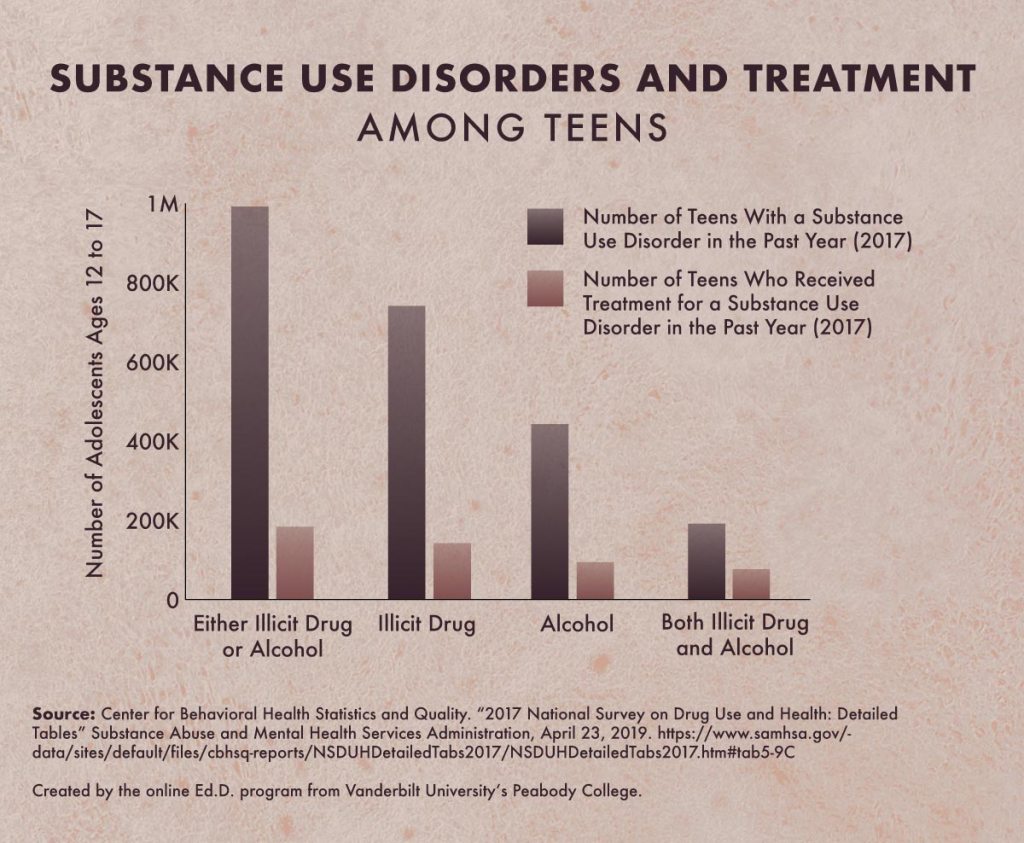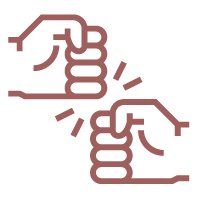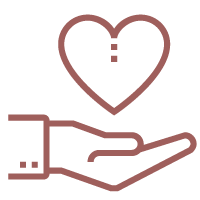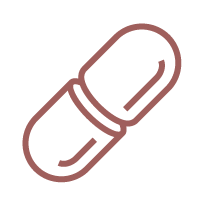Creating a Culture of Recovery for High School Students

For students in recovery from substance use and co-occurring disorders, relapsing is often more common than families might expect. Coming to terms with the likelihood of relapse is an integral part of providing meaningful support.
“Relapse is a very real possibility, and they want to have a system in place when and if it happens,” said Andrew Finch, professor for the campus-based and digital learning programs in Human Development Counseling and co-founder of the Association of Recovery Schools.
Though the state of educational funding makes it unlikely for every public high school to provide integrated support for students in recovery, there is much to learn from the culture and strategies of recovery high schools.
What Is a Recovery High School?
Recovery high schools allow students to learn while in recovery from a substance use or co-occurring disorder in a safe environment, without sacrificing educational opportunities. More than 40 high schools in the country are recognized as recovery schools by the Association of Recovery Schools. According to Finch, recovery high schools focus on a few key areas:
- Educating students in recovery from addiction or substance use.
- Meeting state-level requirements for a high school diploma.
- Supporting students holistically through their ongoing recovery.
While traditional high schools average about 26 students per classroom, recovery high schools admit about 30 students total. Students attending a recovery high school may also be in different grade levels, and the number of credits each student needs to graduate varies.
With such small class sizes, recovery high schools rely and thrive on individualized attention from educators and administrators who tailor curricula to their students’ needs. The curricula accomplish the same learning objectives as traditional public high schools but also include flexible access to clinicians and counselors who can assist with mental and emotional health, as well as recovery supports.
Who Can Attend?
Originally, most recovery high schools limited enrollment to students who had already completed a comprehensive rehabilitation treatment program. However, part of the recovery high school evolution has involved acknowledging that students who are often most vulnerable to risks of addiction may not have equitable access to residential treatment programs close to home or within their family’s financial means.

Approximately 992,000 adolescents ages 12 to 17 reported having a substance use disorder in 2017, according to the National Survey on Drug Use and Health. Only 184,000 teens said they received treatment for a substance use disorder that same year.
As a result, some recovery high schools are opening their doors to students who have not completed a treatment program but are at least trying to stop using alcohol or other drugs.
“That means they might have to modify their program some to embrace kids who haven’t had prior treatments,” Finch said. What matters most is the student’s attitude and open-mindedness.
“The kids that come into a recovery high school really have to be in a place where [they want] to stop their alcohol and drug use,” Finch continued.
What Can Traditional Schools Learn From Recovery Schools?
Finch believes every student can benefit from a more flexible, affirming and nurturing approach to recovery, which requires acknowledgement of the mind, body and spirit.
“They are actively working on healthy life skills,” Finch said. “They’re openly talking about their emotions and what they’re learning from their struggles. They embody wisdom. They embody caring for others.”
This holistic approach to recovery is what sustains an environment geared toward growth. Though a recovery high school is not the only place holistic health is addressed, it can be a refuge for students who may not have access to recovery capital at home.
Recovery capital refers to all the physical and social aspects that contribute positively to one’s recovery:

Supportive family and peers

Access to formal support groups

Mental health counseling

Access to psychiatric medication

Extracurricular activities
Students need access to all of these if they are going to maintain a sober lifestyle without judgment. Finch said families that recognize a need for recovery capital may be more likely or willing to send their children to a recovery school in search of a safe environment.
Though more detailed research is in progress, the outcomes of Finch’s previous studies on the effects of recovery schools are positive so far. Compared to students in traditional environments, students who attend recovery high schools are more likely to report:
- Abstinence from alcohol, marijuana and other drugs after six months.
- Significantly lower levels of marijuana use.
- Less absenteeism from school.
How to Build a Culture of Recovery in Schools
The best system to care for students in recovery requires weaving supports into the fabric of a public-school district, Finch said.
Though the size of most public schools prevents them from developing a true sense of close-knit accountability among all students, he offered a number of ways to learn from the cultures built by recovery high schools.
Identify Opportunities to Intervene
Educators should be trained to be more perceptive about risk factors for students who may be likely to misuse substances. Administrators can work to bring early intervention techniques, screenings and low-intensity treatments to schools for students who may be at risk.
How to Engage in Brief Intervention
Start with one to two sessions of talking to the student privately about substance use.
Help the student understand substance use is causing more problems than they think.
Give strategies to help meaningfully address substance use in the context of their life.
Promote a Holistic Approach
The negative stigma associated with mental health counseling and substance use can keep students from seeking professional help. Combating stigma at every turn is the key to helping students feel empowered to ask for help.
How to Build a Holistic Recovery Culture
Take time to get to know students individually.
Advocate for school-based mental health centers.
Make a referral if unable to provide treatment at school.
Encourage students to check in with their peers and provide support.
Keep a student’s mental health needs confidential from other students.
Address Relapse
Once students receive treatment, they may begin a lifelong journey of recovery, one that often involves relapse.
“Relapse and return to use is the norm; it’s not the exception,” Finch said. “We don’t and can’t expect people to be abstinent for the rest of their lives the day after they leave a treatment center.”
It’s critical to understand that relapsing is an opportunity to learn, and a necessary part of continuing with recovery. What comes after may look different for everyone, but a healthy outcome is founded on several principles of recovery culture:
Attributes of Healthy Culture
- Openness
- Willingness
- Honesty
- Forgiveness
- Acceptance
Neurological changes create memories and a narrative around drug use that makes it very difficult to not use again, Finch said, “but it’s when you use again after treatment that you start to really bring all of those lessons from treatment out into the open.”
For further reading or strategies, consider the following resources:
- The Stigmas, Guilt and Shame of Addiction & Substance Abuse
- Stigma of Addiction | Reducing the Stigma of Substance Abuse
- Teenage Substance Abuse Prevention | Preventing Teen Addiction
- Combating Substance Abuse in Schools | ED.gov Blog
- 9 Ways to Fight Mental Health Stigma | NAMI
- Ending Mental Health Stigma | Project Helping
The following section includes tabular data from the graphic in this post.
Substance Use Disorder and Treatment Among Teens
Number of Teens With a Substance Used Disorder in the Past Year (2017)
| Type of Substance Use Disorder | Number of Adolescents Ages 12 to 17 |
|---|---|
Either Illicit Drug or Alcohol | 992,000 |
Illicit Drug | 741,000 |
Alcohol Drug | 443,000 |
Both Illicit Drug and Alcohol | 192,000 |
Number of Teens Who Received Treatment for a Substance Use Disorder in the Past Year (2017)
| Type of Substance Use Disorder | Number of Adolescents Ages 12 to 17 |
|---|---|
Either Illicit Drug or Alcohol | 184,000 |
Illicit Drug | 143,000 |
Alcohol Drug | 95,000 |
Both Illicit Drug and Alcohol | 77,000 |
Source: Center for Behavioral Health Statistics and Quality. “2017 National Survey on Drug Use and Health: Detailed Tables,” Substance Abuse and Mental Health Services Administration, April 23, 2019.
Citation for this content: The online master’s in school counseling program and online Ed.D program from Vanderbilt University’s Peabody College.


